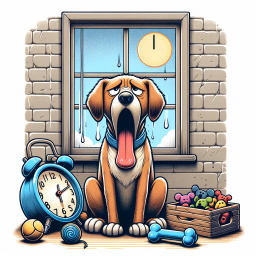Why Does My Dog Sit On My Chest When I Lay Down?

Why Does My Dog Sit On My Chest When I Lay Down? To know the answer, read our full blog post.
Have you ever been in the moment when you’re having fun with your dog and your cute pet doesn’t want anything than to move up and pull close to you? And this probably gets you wondering why does your dog like sitting on your chest?
You’re not alone when it comes to experiencing this as it is one of the things which is common to some dogs and you’re about to find out why that happens.
- 9 Reasons why your dog sits on you
- 1. He wants attention
- 2. To exert dominance
- 3. He gets encouragement from you
- 4. Anxiety
- 5. It is being protective
- 6. Territoriality
- 7. Just for fun
- 8. Warmth
- 9. Show of affection
- Don’t Forget About ACTUAL Training
Why Does My Dog Sit On My Chest When I Lay Down?

9 Reasons why your dog sits on you
1. He wants attention
The reason your dog may be sitting on you always is because your furry friend wants attention.
You’re probably thinking about it right now, moving close to something or someone we love is the best way to get their attention and it’s no different with dogs.
If you have not been spending enough time with your dog and he doesn’t get enough attention, it is likely going to move close to you in the hope of getting you to play with him.
Attending to your dog when he tries to move close to you will help reduce the habit of your pet just sitting on your chest or laps, you could even get up to do some fun activities together.
2. To exert dominance
A point to note is that dogs like most animals evolved into domestication and in the wild being in a higher position is a show of dominance.
The answer to your “why does my dog like sitting on my chest” question maybe because it is trying to show you who the boss is.
If you find that your dog generally likes to into a position higher than yours, sits high on your chest or doesn’t obey commands you give, odds are that your pet doesn’t find you to be the leader.
In such situations, it is advisable to stop him from getting into higher positions than you and trying to reinforce the hierarchy in the relationship.
Dominance in your pet should be discouraged as much possible, you should be able to get your dog to respect you and show it who’s in charge.
3. He gets encouragement from you
When a dog sits on the owner’s chest when they lay down, one of the first things they do is to offer him treats and toys.
Does this seem like something you also do?
Then you may have been encouraging your dog to do this more often. It’s just that simple!
Dogs view rewards and treats as a form of encouragement for good behavior. If your dog receives treats for getting on your body then it’s likely to do that more often.
There are other ways to get your dog to obey your commands without having to offer rewards.
Offering rewards for a bad habit in a dog is only going to cause it to happen more often. Sometimes all you need to do is to train your dog not to sit on you more often.
4. Anxiety
The truth is that it’s almost impossible to be home always. There are times when you have to be away from home for hours and that means being away from your dog also.
Sometimes dogs don’t like being left alone especially when the absence comes suddenly.
If you find your dog becomes anxious when you’re about to leave then it may be suffering from separation anxiety. This can be displayed by crying or other shows of anxiety.
A dog that experiences separation anxiety is likely to sit on your chest or other parts of your body when you’re home to prevent you from leaving often.
Anxiety in dogs isn’t really good and your dog can be trained to be less anxious by leaving it at home for short periods and increasing the time away gradually.
5. It is being protective
Here’s a secret, certain breeds of dogs are more protective than the others.
These dogs are likely to go wherever you go.
They also try to protect you from other dogs and humans. This can lead to them being overprotective, something like a jealous girlfriend.
Among the ways your dog may portray its protectiveness include getting on laps and chest, following you around and barking at strangers.
The cool thing is that your pet can be slowly trained to reduce over-protectiveness by introducing it to others and reducing extensive attachment to you.
6. Territoriality
Fact is dogs can sometimes lay a claim to property or spaces and that includes you.
If your dog sees you as belonging to it, it is likely to spend time more time with you licking and spreading its smell [1].
Spreading its scent to you will make other dogs realize that you belong to it so they don’t get too close. What better way to spread its scent than to lie on your chest and rub its furs over you all day.
It is possible to prevent this habit in your dogs through training. Your dog can be trained to sit elsewhere instead of your chest or laps.
7. Just for fun
Another reason your dog sits on your chest is that he wants to play or have fun. Different breeds of dogs sometimes sit on their owners just for fun and just because they can.
At the times when your dog wants to play, he could climb up on your chest or laps and roll around frequently.
Every dog deserves and requires a little bit of playtime and your reaction to your dog getting close to you at that moment depends on you.
If you’re in the mood to play then go ahead and have some fun with your dog and if you’re not it’s best to also let the dog realize that also.
8. Warmth
The truth is that everyone needs a little bit of warmth every once in a while and dogs are no different.
It is likely that the heat being generated from your body is just what it requires at that moment.
In a situation where your dog finds your body to be warm, he is likely going to claw its way up to your chest or your laps.
In the process of getting close to you, he could get rewarded by you unconsciously which makes it want to do this more often.
9. Show of affection
Dogs are very loving and affectionate creatures and having one will help you realize how affectionate they can be.
Most times when your dog needs affection, it is likely to climb to your chest and get you to rub its belly or pet it in other ways.
Your dog showing you affection is a sign that it loves you and enjoys being around you.
It’s pretty obvious when you think about it and odds are if you are a good pet-parent you’ll most likely feel the same.
In the end, the choice is fully yours. Your dog lying on your chest or other parts of your body is almost always a good sign which just helps them display love and affection among other things.
If there are times when you need to be alone however, you can let your dog know that. It will probably hurt your pet’s feelings a little but he will be fine.
Don’t Forget About ACTUAL Training
While treats and toys may help to keep your dog busy and stimulate him, they do not replace training. Just like we need to enrich our kiddies, we need to dedicate time to help our dog’s brains develop. It shouldn’t just be entertainment and treats every time! It’s sort of synonymous with placing a child in front of a T.V. and expecting to improve their overall behavior and well-being.
And training your dog isn’t just about getting them to shake a paw or sit when you ask them to. It should be about making them more intelligent. A more intelligent dog will:
- be more obedient
- have better temperament
- have a stronger bond with you
- learn new skills faster
- not have resistance and anxiety problems
So if you’re a new dog parent to a puppy or adult dog, or you’re just wanting to learn some new skills, I recommend embarking in some sort of training. Professional training, however, can be quite expensive and time-consuming. I really like this training course (opens a new tab). It’s online, it was created and often updated by a professional dog trainer and it really helps you understand how to better stimulate and enrich your puppy’s (or dog’s) life.
You’ll also get access to a private forum and updated content. Don’t get me wrong, while applying the techniques in this course won’t make your dog a diva under a week, its slow, gradual method will see your dog transforming into a more intelligent dog that can take instructions obediently and help you to understand how you may be able to make changes in your approaches with training and trying to change behaviors.
It’s really not that expensive and a resource I think a lot of dog parents can benefit from. Interestingly, there is a 100% money-back guarantee in place should you find the course unfit for your dog.
I hope you have got a full idea what to do if your Dog Sit On My Chest When your Lay Down.
Related Posts:
Read More: Why Does My Dog Open His Mouth When I Pet Him? 7 Reasons
Read More: Why Does My Dog Keep Sniffing My Legs: 5 Common Reasons
Read More: Why Does My Dog Bite Me In The Morning? 2 Way To safe From
Read More: Why Are My Dogs Balls Black? Best Number 1 Answer
Read More: Why Do Dogs Like Peanut Butter?
Read More: Why Does My Dog Nibble My Ear? 10 Reasons
Read More: Why Does My Dog Move Its Bed Around?
Read More: Why Does My Dog Bring Me His Food?
Read More: Why Does My Dog Lay His Head Over My Neck? 7 Reasons
Read More: Can Dogs Have Brown Sugar? 7 Effects





